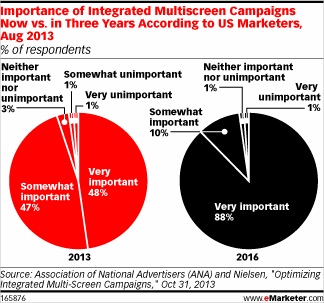-
True Multi-Channel Advertising is Still Elusive in Video
Wednesday, April 9, 2014, 2:10 PM ETPosted by:In today's connected world, a multi-channel strategy is an important area of focus and logical aspiration: Marketers looking to engage the uber-linked consumer base are hungry for the right recipe. Ad tech suppliers gear more of their development efforts to the cause each quarter, and agencies tout their growing multi-channel capabilities to deliver on its promise. We are believers in the potential to thread messages to consumers on various devices throughout the day via advanced campaign and creative capabilities.
Since mobile is the highest consumer growth area and most complicated tech challenge, let's explore this medium first: In Cathy Boyle's March 5, 2014 eMarketer report, "Mobile Ad Targeting: After Years of 'Spray and Pray,' Signs of Sophistication Appear," the analyst reflects on the current aspirational state and asserts that change finally is near. "Most agree that multi-device targeting is the best way to move forward, but the practices used to target ads across devices needs time to mature. Considering the high degree of importance marketers place on multi-screen advertising, brands are not likely to want to wait too long. 2014 is likely to be the year in which big brands experiment more boldly and put innovative cross-screen advertising practices to the test."

While marketers are oscillating their thinking toward a fully realized multi-channel (aka "multiscreen" aka "cross-platform") strategy, it is still very much a quest. So, what has to happen to make this pursuit a reality?
Acknowledging the Mix is just the Start
While marketers recognize that their audience spends time with many screens throughout the day, and it's necessary to message across them all to maximize exposure, that's just table stakes. Having an established multi-channel media mix in play helps establish daypart continuity but it doesn't mean you've got a strategy in place for doing it right. Delivering on the promise of the mix is predicated on establishing tracking and measurement capabilities and nailing the creative piece.
Achieving the Next State of Measurement
In order to measure across devices, you need to be able to find a common measurement currency across ALL devices. Mobile/tablet operating systems offer technical challenges that don't exist elsewhere. For instance, Nielsen's TV measurement is tried and true and desktop video has been measured in similar fashion of late, but the mobile video validation isn't quite there yet. In spite of near-term limitations, there still seems to be a preoccupation with finding users to re-market to using layer after layer of targeting (a primarily digital media proclivity). We should be careful not exaggerate the current state of multi-screen capability and commit to work toward the future state. Truthfully, until there is a fully baked way to anonymously track consumers from screen-to-screen, we risk disappointing marketers instead of inspiring them.
Valuing Different Screens Differently
An important, yet rarely deliberated consideration in cross-screen conversation is the relative value of distinct screens. It would be easy, and misguided, to simply set all video advertising values equally based on ability to reach the desired demo. Various devices attract audiences in various states of mind. Television, the undisputed king of brand advertising, is a classic lean back medium. Viewers are entertained on big beautiful screens as a pleasant respite from the daily grind. Desktop video reaches the elusive multi-tasking "at work audience." Video on mobile devices balances these experiences reaching active consumers looking to consume great full screen content on their terms, regardless of location.
Another day, we may debate the comparative value of each medium but, for now, I hope we can agree that it makes no sense to lump them all together at a uniform (CPP) price point. That would make about as much sense as all the countries in Europe getting together to share a currency (oh wait - how is that working out?).
Creative Preparation
As mentioned, marketers who truly embrace the promise of multi-screen must acknowledge that consumers are in different mindsets, depending on the screen and setting. What about creative sequencing, not only tailoring creative to each environment but delivering creative ideas to play across screens?
Imagine you represent a QSR or retail brand. We know smartphone owners are on-the-go, accessing mobile media from everywhere they roam. This is a great opportunity to capitalize on their mobility and the spontaneity that can result from spare time: tell them where your closest brick-and-mortar location is, and suggest a reason to pop in for a visit. Tablet owners, especially in the evening, are relaxing at home or maybe on their commute - a totally different frame of mind. Give them a reason to remember the brand with messaging that is light and entertaining, or drive them to a specific place on the web to interact (or transact).
Finally, as we move out of the awkward adolescent phase of cross device targeting, it's worth noting that marketers may still regard TV as the primary screen, with other screens as incremental or adjacent. While television still dominates reach and screen size, strategies and campaigns that consider other devices as afterthoughts will likely fall short of the rich multi-screen opportunity.
An evolved planning approach regards the actual media habits and mindsets of its target audience in different arenas and selects screens based on aggregate reach and audience objectives and then develops campaigns, creative and measurement approaches accordingly.Categories: Advertising, Mobile Video
Topics: blinkx, Rhythm NewMedia



